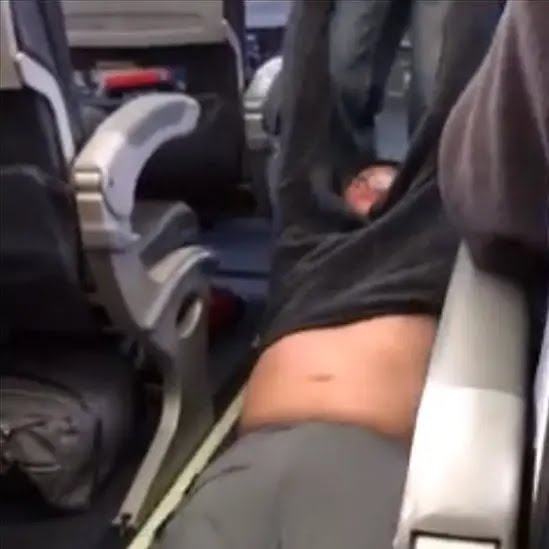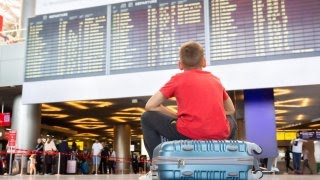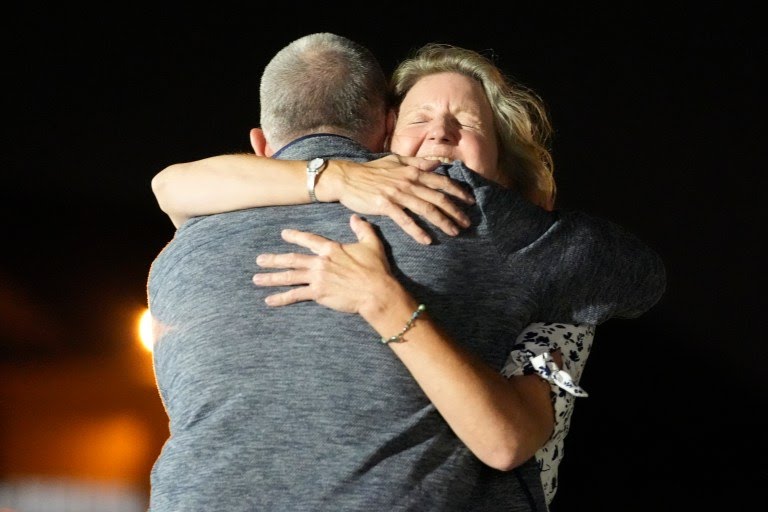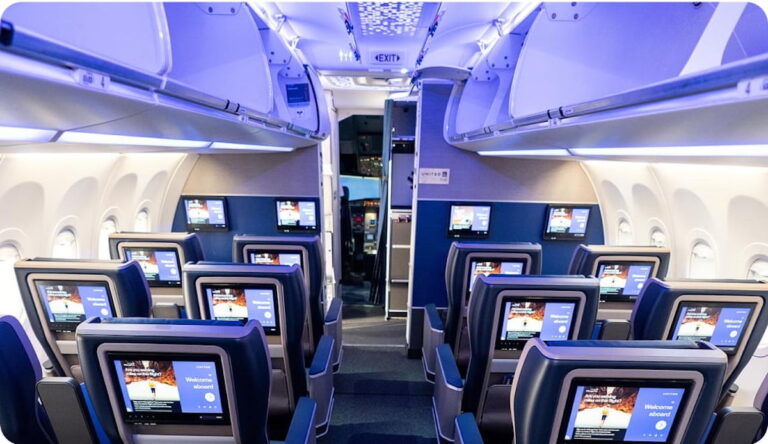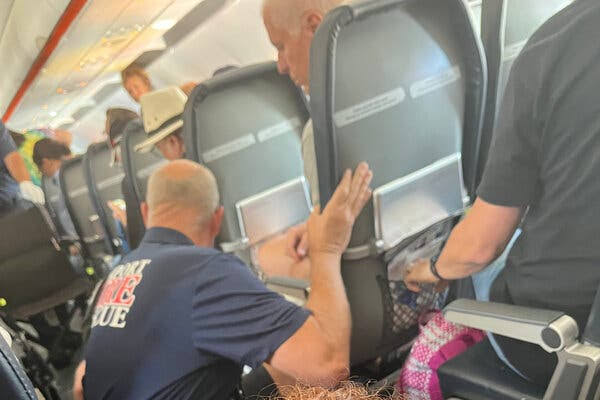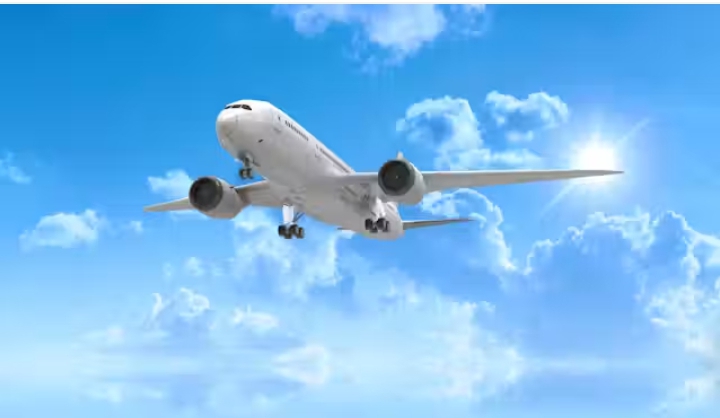United Airlines incident: What went wrong?
A common seating problem on a United Airlines flight on Sunday ended with a man being bloodied and dragged from his seat and an already troubled airline earning more bad press. How did it all go so wrong?
Overbooking on flights happens all the time. Airlines boost their profit margins by overselling, betting against the number of passengers who will miss their flights.
In this case, the problem arose because United decided at the last minute to fly four members of staff to a connection point and needed to bump four passengers to make way for them.
When there’s a seating issue the first step is to offer an inducement to the passengers to take a later flight. On Sunday passengers were offered $400 (£322), a hotel room for the night and a flight the following afternoon.
When no-one took the offer, the amount was upped to $800. Still no-one bit, so a manager boarded the flight and informed passengers that four people would be selected to leave the flight.
That selection is based on several factors, but frequent fliers and higher fare-paying passengers are given priority to stay aboard, a spokeswoman for United confirmed
A couple who were selected agreed to leave the plane voluntarily. A third passenger, reportedly the wife of the man who was forcibly removed, also agreed. The man, who said he was a doctor and had to see patients in the morning, refused.
At this point, the airline could have identified another passenger for removal or raised its offer anywhere up to a maximum of $1,350.
Erin Benson, a spokeswoman for United, could not confirm whether other passengers were sought. She did confirm that no offer was made above $800, but could not comment on why.
According to eyewitnesses, the man who refused to be ejected said he was a doctor and he had appointments to keep the following day, though this has not been confirmed. This was a Sunday night flight; the next flight on offer didn’t leave until 15:00 on Monday.
An eyewitness said the man was “very upset” about the possibility of being bumped and attempted to call his lawyer. An airline manager told him that security would be called if he did not comply.
At this point, security officers came to speak to him, first one then two more. As the video shows, their conversation ended with the man being yanked from his seat onto the floor and dragged off, blood visible on this face.
United is technically within its rights to forcibly remove the man for refusing to leave the flight, and the step is part of the airline’s carriage guidelines, but such instances are extremely rare.
Of the 613 million people who flew on major US carriers in 2015, 46,000 were involuntarily denied boarding, according to data from the Department of Transportation – less than 0.008%.
The majority of those would have been informed before they boarded the flight, said Charles Leocha, the founder of passenger advocacy group Travelers United. He could not remember seeing a passenger violently dragged off a plane. “It turned my stomach,” he said.
Removing passengers at the last minute to make way for staff was also highly unusual, he said. Staff transport should be identified ahead of time and factored into bookings.
US fliers have become resigned to chronic delays and poor service, according to Mr Leocha, and a lack of readily available information about their rights meant they were too dependent on the airline managers in situations like these.
“Our expectations have been driven so low that passengers have begun to accept it,” he said. “What they shouldn’t have to accept is being dragged off the flight to make way for an employee.”
Oscar Munoz, CEO of United, said in a statement: “This is an upsetting event to all of us here at United. I apologize for having to re-accommodate these customers.”
Mr Munoz said the airline would review the event and “reach out” to the passenger, though a spokeswoman could not confirm whether United was in touch with him yet.
One of the security officers involved in the incident was suspended on Monday afternoon, pending a review, said the Chicago Department of Aviation in a statement.
The actions of the officer were “obviously not condoned by the Department”, the statement said.
Whatever happened on the flight – and the details will undoubtedly emerge in the coming days – it was a bad day for United, Mr Leocha said. The airline had only recently been at the centre of another controversy, when a fortnight ago it refused to let two girls board because they were wearing leggings.
“This isn’t really a lesson for passengers it’s a lesson for airlines,” he said. “The only lesson here for passengers is when security get on throw up your hands, because otherwise you’re going down the aisle with a fat lip.”
A common seating problem on a United Airlines flight on Sunday ended with a man being bloodied and dragged from his seat and an already troubled airline earning more bad press. How did it all go so wrong?
Overbooking on flights happens all the time. Airlines boost their profit margins by overselling, betting against the number of passengers who will miss their flights.
In this case, the problem arose because United decided at the last minute to fly four members of staff to a connection point and needed to bump four passengers to make way for them.
When there’s a seating issue the first step is to offer an inducement to the passengers to take a later flight. On Sunday passengers were offered $400 (£322), a hotel room for the night and a flight the following afternoon.
When no-one took the offer, the amount was upped to $800. Still no-one bit, so a manager boarded the flight and informed passengers that four people would be selected to leave the flight.
That selection is based on several factors, but frequent fliers and higher fare-paying passengers are given priority to stay aboard, a spokeswoman for United confirmed
A couple who were selected agreed to leave the plane voluntarily. A third passenger, reportedly the wife of the man who was forcibly removed, also agreed. The man, who said he was a doctor and had to see patients in the morning, refused.
At this point, the airline could have identified another passenger for removal or raised its offer anywhere up to a maximum of $1,350.
Erin Benson, a spokeswoman for United, could not confirm whether other passengers were sought. She did confirm that no offer was made above $800, but could not comment on why.
According to eyewitnesses, the man who refused to be ejected said he was a doctor and he had appointments to keep the following day, though this has not been confirmed. This was a Sunday night flight; the next flight on offer didn’t leave until 15:00 on Monday.
An eyewitness said the man was “very upset” about the possibility of being bumped and attempted to call his lawyer. An airline manager told him that security would be called if he did not comply.
At this point, security officers came to speak to him, first one then two more. As the video shows, their conversation ended with the man being yanked from his seat onto the floor and dragged off, blood visible on this face.
United is technically within its rights to forcibly remove the man for refusing to leave the flight, and the step is part of the airline’s carriage guidelines, but such instances are extremely rare.
Of the 613 million people who flew on major US carriers in 2015, 46,000 were involuntarily denied boarding, according to data from the Department of Transportation – less than 0.008%.
The majority of those would have been informed before they boarded the flight, said Charles Leocha, the founder of passenger advocacy group Travelers United. He could not remember seeing a passenger violently dragged off a plane. “It turned my stomach,” he said.
Removing passengers at the last minute to make way for staff was also highly unusual, he said. Staff transport should be identified ahead of time and factored into bookings.
US fliers have become resigned to chronic delays and poor service, according to Mr Leocha, and a lack of readily available information about their rights meant they were too dependent on the airline managers in situations like these.
“Our expectations have been driven so low that passengers have begun to accept it,” he said. “What they shouldn’t have to accept is being dragged off the flight to make way for an employee.”
Oscar Munoz, CEO of United, said in a statement: “This is an upsetting event to all of us here at United. I apologize for having to re-accommodate these customers.”
Mr Munoz said the airline would review the event and “reach out” to the passenger, though a spokeswoman could not confirm whether United was in touch with him yet.
One of the security officers involved in the incident was suspended on Monday afternoon, pending a review, said the Chicago Department of Aviation in a statement.
The actions of the officer were “obviously not condoned by the Department”, the statement said.
Whatever happened on the flight – and the details will undoubtedly emerge in the coming days – it was a bad day for United, Mr Leocha said. The airline had only recently been at the centre of another controversy, when a fortnight ago it refused to let two girls board because they were wearing leggings.
“This isn’t really a lesson for passengers it’s a lesson for airlines,” he said. “The only lesson here for passengers is when security get on throw up your hands, because otherwise you’re going down the aisle with a fat lip.”
A common seating problem on a United Airlines flight on Sunday ended with a man being bloodied and dragged from his seat and an already troubled airline earning more bad press. How did it all go so wrong?
Overbooking on flights happens all the time. Airlines boost their profit margins by overselling, betting against the number of passengers who will miss their flights.
In this case, the problem arose because United decided at the last minute to fly four members of staff to a connection point and needed to bump four passengers to make way for them.
When there’s a seating issue the first step is to offer an inducement to the passengers to take a later flight. On Sunday passengers were offered $400 (£322), a hotel room for the night and a flight the following afternoon.
When no-one took the offer, the amount was upped to $800. Still no-one bit, so a manager boarded the flight and informed passengers that four people would be selected to leave the flight.
That selection is based on several factors, but frequent fliers and higher fare-paying passengers are given priority to stay aboard, a spokeswoman for United confirmed
A couple who were selected agreed to leave the plane voluntarily. A third passenger, reportedly the wife of the man who was forcibly removed, also agreed. The man, who said he was a doctor and had to see patients in the morning, refused.
At this point, the airline could have identified another passenger for removal or raised its offer anywhere up to a maximum of $1,350.
Erin Benson, a spokeswoman for United, could not confirm whether other passengers were sought. She did confirm that no offer was made above $800, but could not comment on why.
According to eyewitnesses, the man who refused to be ejected said he was a doctor and he had appointments to keep the following day, though this has not been confirmed. This was a Sunday night flight; the next flight on offer didn’t leave until 15:00 on Monday.
An eyewitness said the man was “very upset” about the possibility of being bumped and attempted to call his lawyer. An airline manager told him that security would be called if he did not comply.
At this point, security officers came to speak to him, first one then two more. As the video shows, their conversation ended with the man being yanked from his seat onto the floor and dragged off, blood visible on this face.
United is technically within its rights to forcibly remove the man for refusing to leave the flight, and the step is part of the airline’s carriage guidelines, but such instances are extremely rare.
Of the 613 million people who flew on major US carriers in 2015, 46,000 were involuntarily denied boarding, according to data from the Department of Transportation – less than 0.008%.
The majority of those would have been informed before they boarded the flight, said Charles Leocha, the founder of passenger advocacy group Travelers United. He could not remember seeing a passenger violently dragged off a plane. “It turned my stomach,” he said.
Removing passengers at the last minute to make way for staff was also highly unusual, he said. Staff transport should be identified ahead of time and factored into bookings.
US fliers have become resigned to chronic delays and poor service, according to Mr Leocha, and a lack of readily available information about their rights meant they were too dependent on the airline managers in situations like these.
“Our expectations have been driven so low that passengers have begun to accept it,” he said. “What they shouldn’t have to accept is being dragged off the flight to make way for an employee.”
Oscar Munoz, CEO of United, said in a statement: “This is an upsetting event to all of us here at United. I apologize for having to re-accommodate these customers.”
Mr Munoz said the airline would review the event and “reach out” to the passenger, though a spokeswoman could not confirm whether United was in touch with him yet.
One of the security officers involved in the incident was suspended on Monday afternoon, pending a review, said the Chicago Department of Aviation in a statement.
The actions of the officer were “obviously not condoned by the Department”, the statement said.
Whatever happened on the flight – and the details will undoubtedly emerge in the coming days – it was a bad day for United, Mr Leocha said. The airline had only recently been at the centre of another controversy, when a fortnight ago it refused to let two girls board because they were wearing leggings.
“This isn’t really a lesson for passengers it’s a lesson for airlines,” he said. “The only lesson here for passengers is when security get on throw up your hands, because otherwise you’re going down the aisle with a fat lip.”
